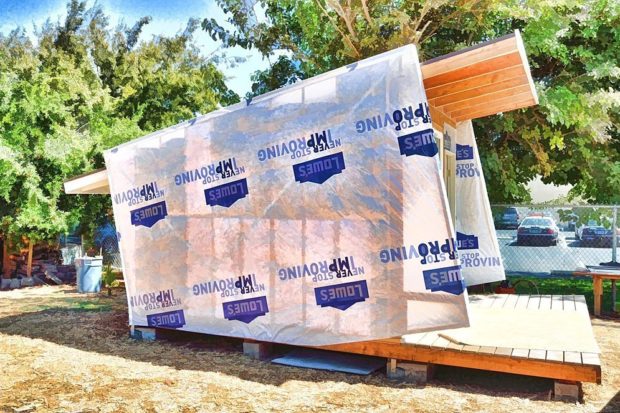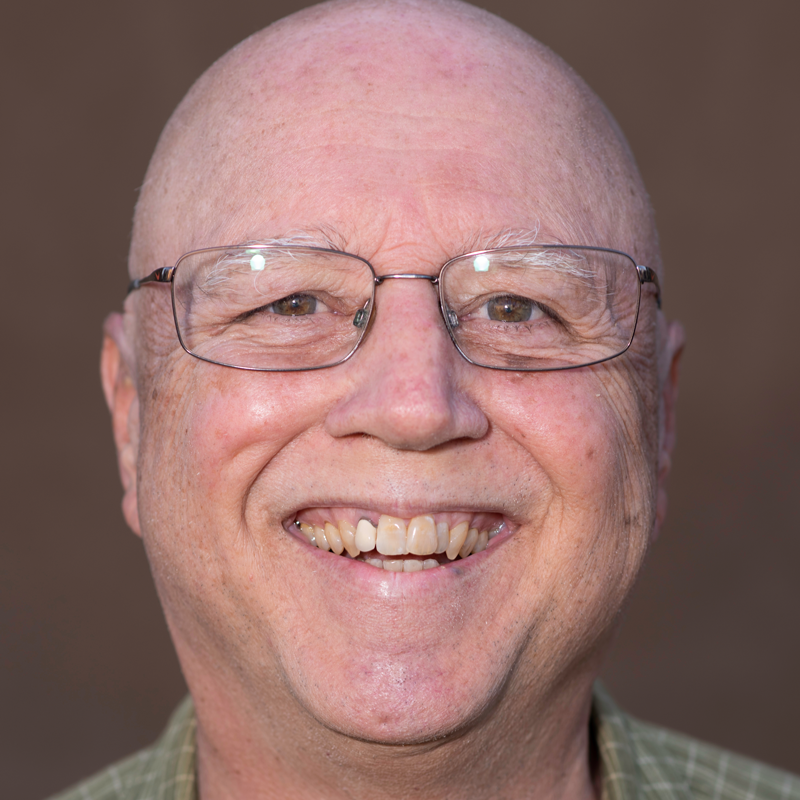
By Dixie Salazar, Gerry Bill and Nancy Waidtlow

The Eco Village project began as the brainchild of celebrated local architect Arthur Dyson. Dyson’s original idea was to create green, sustainable eco housing that would provide the homeless with an uplifting, dignified, harmonious and aesthetically pleasing living environment. The original concept involved creating communities of people with similar skills living and working together.
Perceiving an immediate need, however, in 2009, the original board (Dyson, Gerry Bill, Mike Rhodes, Dixie Salazar, Bill and Marla Hartman, Al Williams and Cynthia Greene) pooled their resources to develop a homeless drop-in center. This project, for many reasons, did not come to fruition; however, Cynthia Greene, who was formerly homeless, was able, with the group’s help, to buy the property, with the plan of helping her homeless friends.
After going through a few organizational changes, the board (currently consisting of Dyson, Bill, Salazar, Nancy Waidtlow, Alicia Andrade and Bev Fitzpatrick) has shifted its concentration to the Eco Village Project, which has a mission to provide safe, sanitary and dignified housing for the homeless in an environmentally sustainable manner. In 2010, the Eco Village Project, through Bill and Salazar’s efforts received 501(c)(3) status.
With a meandering pathway of housing units, arboreal landscaping, an organic garden and personal garden spaces around each individual unit, the Eco Village will promote a healthy, peaceful and enriching environment. Each dwelling will be approximately 110 square feet, with geothermal and convection cooling and solar heating. Other features will include rainwater catching and gray-water recycling systems. Communal aspects such as kitchens, laundry, showers, bathrooms, dining areas and workshops will foster an atmosphere of cooperation and a sense of investment in a shared living space.
Each village will have an economic and self-sustaining component such as an organic garden, solar chimney production, bicycle and auto repair, carpentry or sewing and garment repair and reconstruction. These aspects of the project will promote self-fulfillment and renewal to help the homeless transition into longer-term living situations, as well as eventual permanent housing. Mentoring and apprenticeship will be integral to the project, as well as community involvement.
Fresno State and Fresno Pacific University will work closely with the Eco Village residents in providing vital counseling and tutoring for the residents. Tree Fresno will assist in providing a park-like setting for the residents and surrounding neighbors.
The philosophical foundation of the Eco Village rests on the belief that in order to achieve lasting change, individuals must undergo a transformation within themselves. Living in a cooperative community will provide opportunities to develop leadership skills, self-respect, pride and social responsibility, taking part in the building process of the units themselves and by partaking of maintenance and self-governance. Social service components will be provided through referrals and volunteer services.
The stumbling block for the Eco Village project has always been the acquisition of property suitable for its needs After attending advocacy meetings for many months, and hoping to move from talk to action, Waidtlow found and bought a 0.59-acre lot in west central Fresno that Dyson and the rest of the board agreed would be a good place to try out some of the Eco Village ideas, and especially to build a prototype of the Dyson-designed eco shelters. Waidtlow wanted to provide some housing and at the same time demonstrate that it doesn’t have to cost a fortune to create a safe, stable and even uplifting environment for the homeless.
At the time of this writing, the Dakota EcoGarden (the name of Waidtlow’s project) has four residents, two living in the house on the property, one in the first eco shelter and one in a tent on a platform in the yard. Residents will be added gradually, in tents for now, moving into Eco Shelters as they are built with the residents’ help. The well-being of the residents and of the surrounding neighborhood will be considered in the ultimate determination of how many residents may live on the site. As neighbor complaints are the biggest reason (or excuse) for punitive action against the homeless, great emphasis will be put on being good neighbors.
The EcoGarden may be able to share food from the garden or even offer a few community garden plots. The upper floor of the house is expected to provide rental income, which, along with the entrepreneurial efforts of the residents, will help support the project. Gardening, using the sun for energy when possible, conserving water, using bicycles for transportation—these are some examples of how the EcoGarden will employ ecological principles.
The house common areas will be used for meetings, classes, workshops and other support services that will help residents meet their own personal goals. It may be that they will also find the special joy that can come from finally being able to help others rather than always being the ones most in need of help.
We are currently entering a time of transition, possibly even transformation, for both the Eco Village Project and the Dakota EcoGarden. The two projects had been evolving at a slow but steady pace, but the momentum grew quickly when the City of Fresno began its new round of homeless evictions. The evictions, which began in August and continued into October, eliminated all but the most hidden encampments in Fresno and displaced hundreds of people. Compounding the problem were the coming of winter and a new police task force making sure that no one put up any shelter for more than one night.
Fortunately, the prototype eco shelter being built on the grounds of the Dakota EcoGarden was nearing completion. It soon acquired its first resident, bringing a homeless person in off the streets. Building on that success, the EcoGarden took in additional formerly un-housed people, creating new spaces for them as they arrived. As there was not enough time to construct a second eco shelter before winter set in, some of the new residents have been housed in tents erected on plywood platforms. Thus, in this unique setting, Waidtlow’s EcoGarden project has blended with the Eco Village project’s prototype units. Their function and serviceability will be assessed by their homeless residents, with the idea of fine-tuning the units for future projects.

These developments have opened up several new possibilities for the future direction of the two projects. One possibility, currently under consideration, is for the Eco Village Project to acquire a larger piece of land and put new units on it—possibly as many as 20–30 on one site. As the project scales up in size, it may become necessary for the eco shelters to be prefabricated on one site and erected on another site. In that case, there would be a need for a large contingent of volunteer workers, most likely being supervised by an experienced building contractor. The volunteer workers probably would include some recently un-housed people who would live on the site. These workers would be earning a type of sweat equity in what might become their future homes.
The Dakota EcoGarden is also in a period of transition. New organizational structures are evolving to handle the increased number of residents. There is now a formalized intake process and a procedure for screening potential residents. Basic rules are in effect. Residents are taking on some of the responsibilities of maintenance. Regular community meetings are held, elements of self-governance are being introduced and residents are developing a sense of community. Over time, the primary responsibility for running the site will be in the hands of the residents.
If the EcoGarden proves to be a successful model for providing transitional housing in a small community setting, the project may become a model for similar efforts elsewhere in the Fresno area. There are some advantages to keeping transitional housing communities small and having several of them located at various places in the community.
The Eco Village and EcoGarden models will not work for everyone in the homeless population. Understandably, a different model is needed to provide a safe and legal living space for those who are not able to adjust to the standard of social behavior required of residents of the Eco Village or EcoGarden. There is no one solution to the problem of homelessness.
The immediate necessity of housing the recently evicted homeless before the worst of the winter weather is here has been the driving force behind the rapid developments that have been occurring both in the Eco Village Project and in the Dakota EcoGarden. This is an exciting time for everyone involved in these two projects.
Speaking of involvement—there are opportunities opening up for more and more volunteer helpers to come forward and pitch in. The projects need help in many categories. Help will be needed with design and construction work on the eco shelters, either at the EcoGarden, a new Eco Village site, or both. The EcoGarden is also a garden, and help is always needed with maintaining the garden itself. Help also will be needed in arranging activities and support services for the residents housed at the EcoGarden or at a larger Eco Village site.
People can also help by donating cash or building materials or other material items that might be needed by camp residents. Tax-deductible donations may be made to either the Eco Village Project itself or to the Dakota EcoGarden. In either case, checks should be made out to The Eco Village Project of Fresno, and if the funds are intended for the Dakota site then the word “EcoGarden” should be written on the memo line of the check.
*****
Dixie Salazar, Gerry Bill and Nancy Waidtlow are board members of the Eco Village Project of Fresno.

